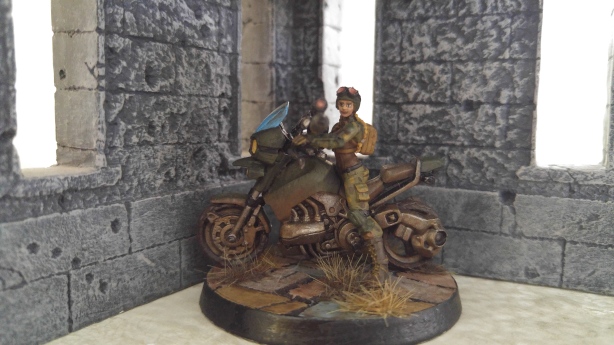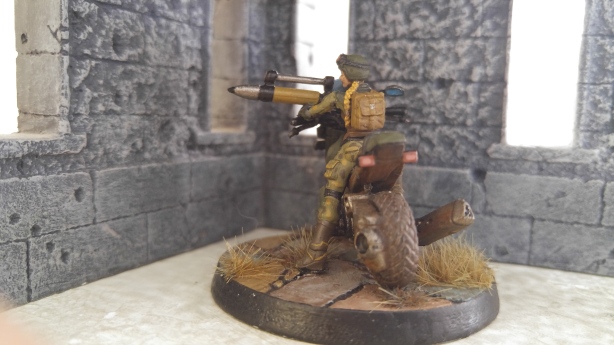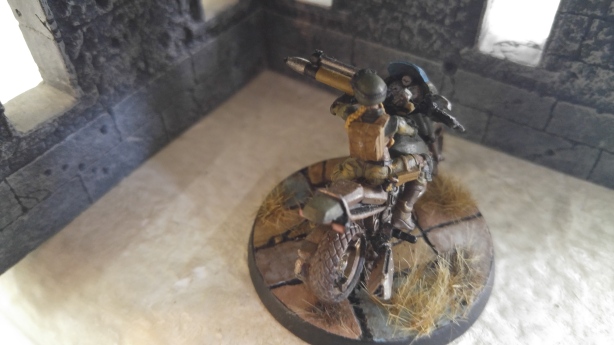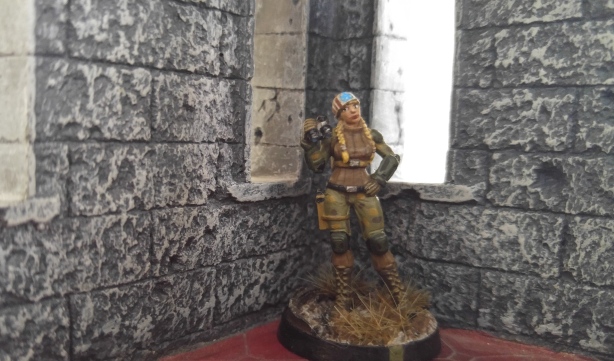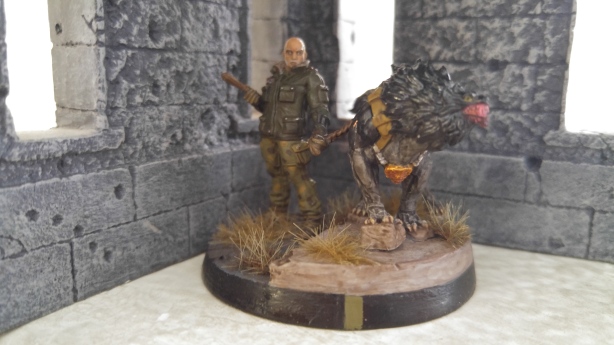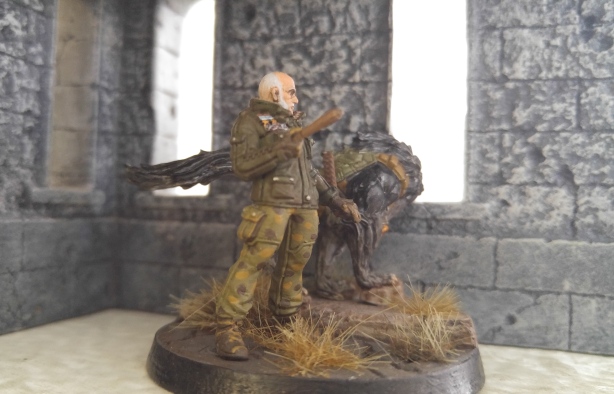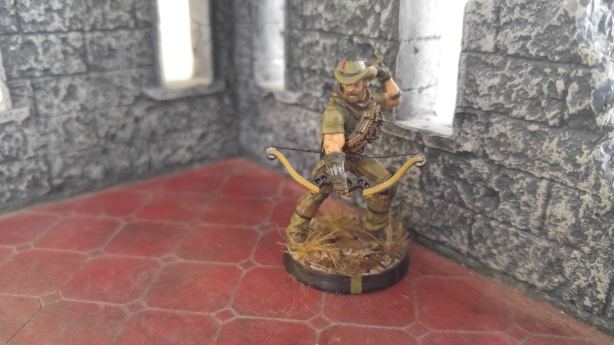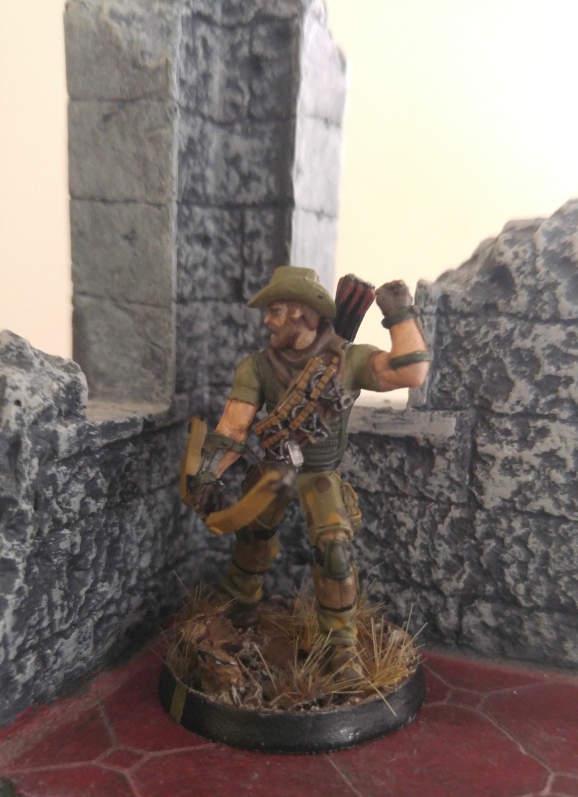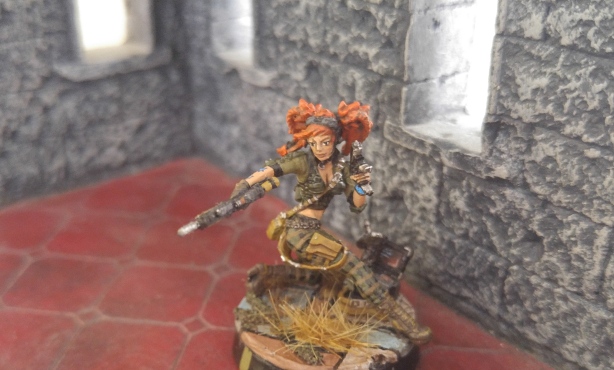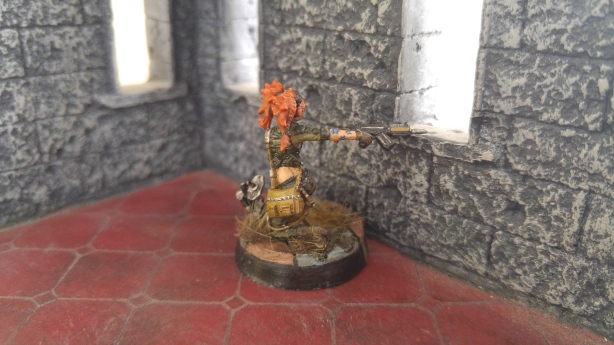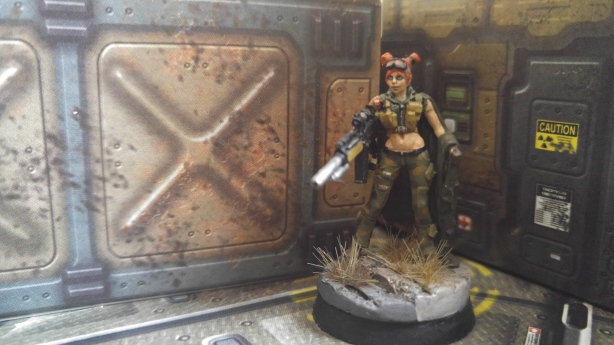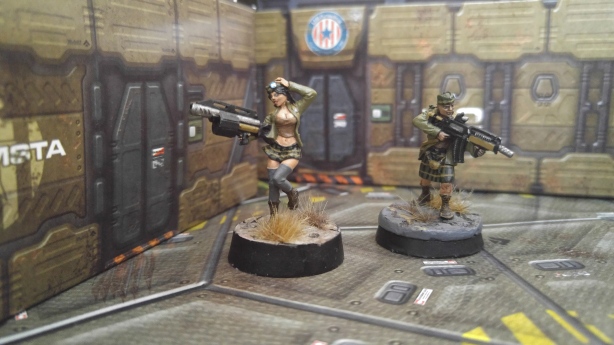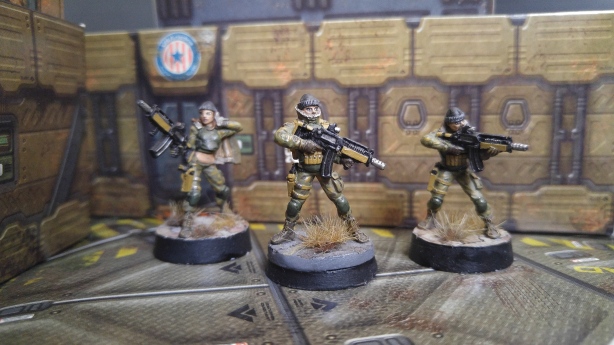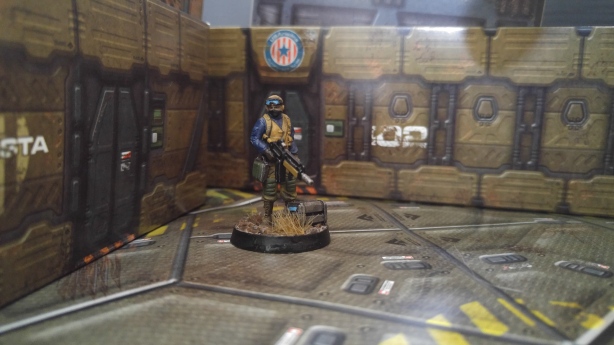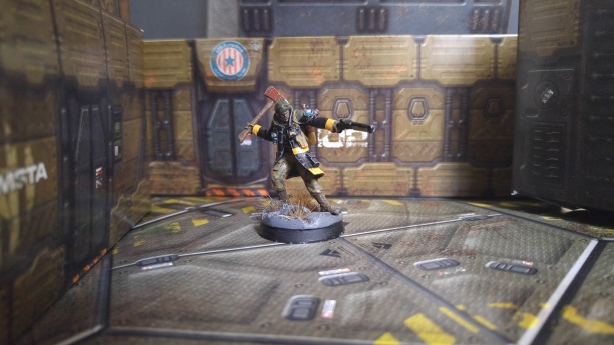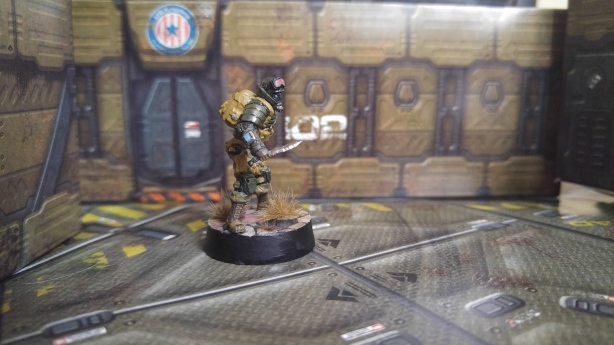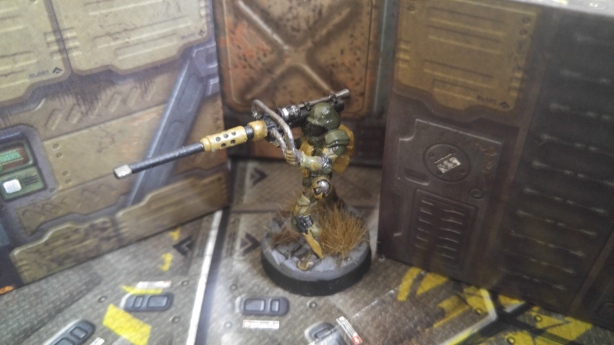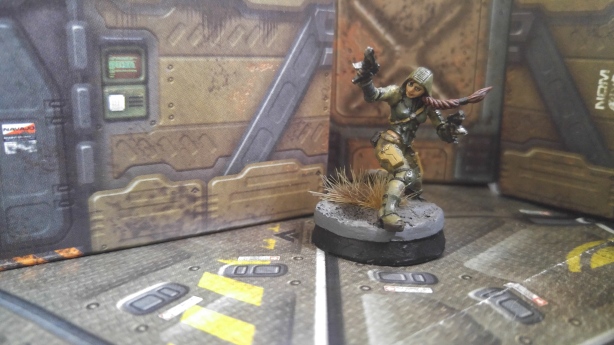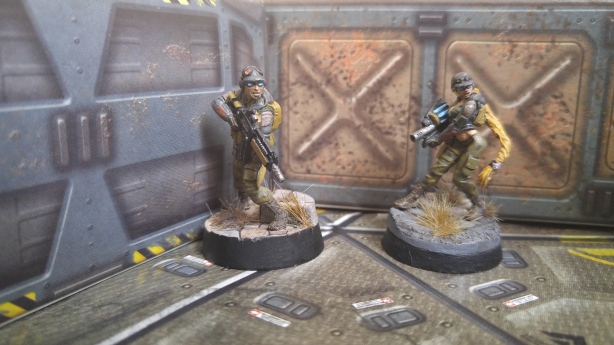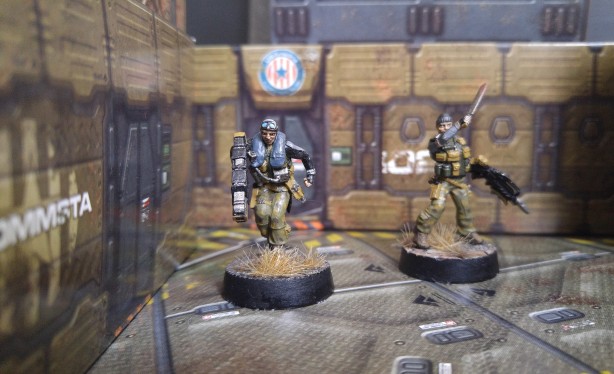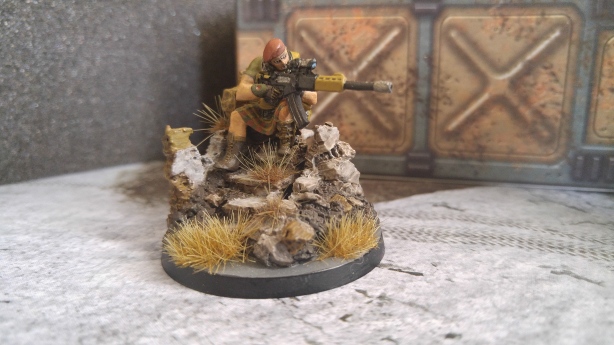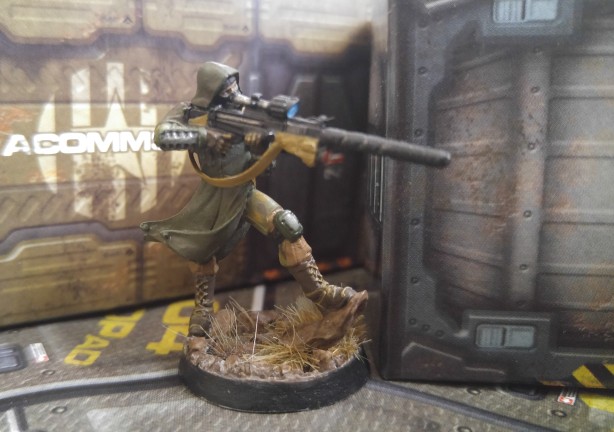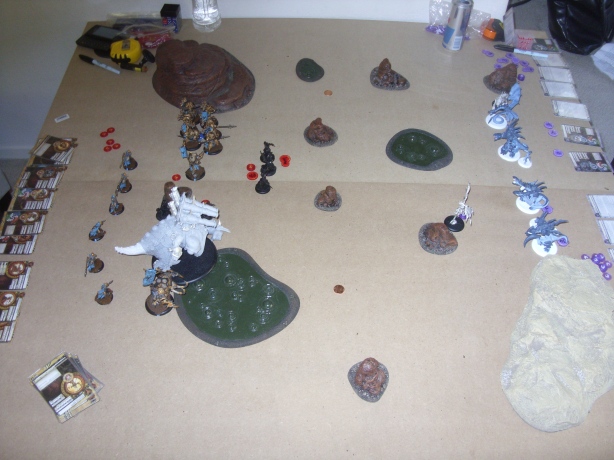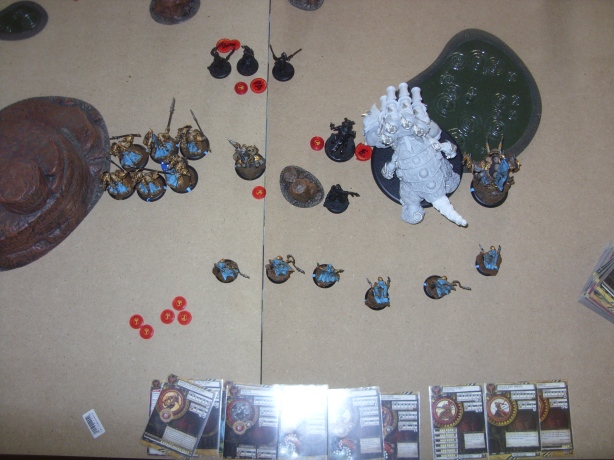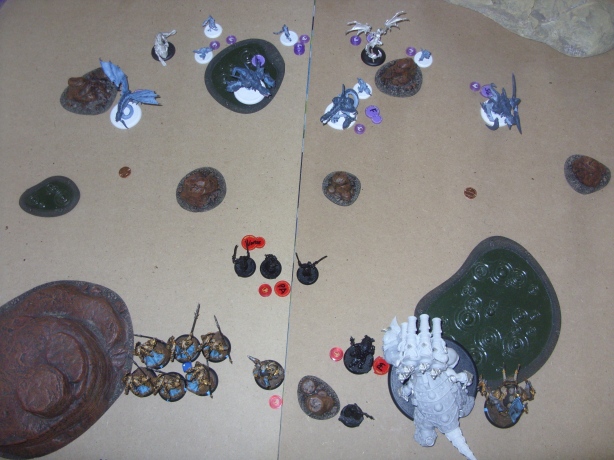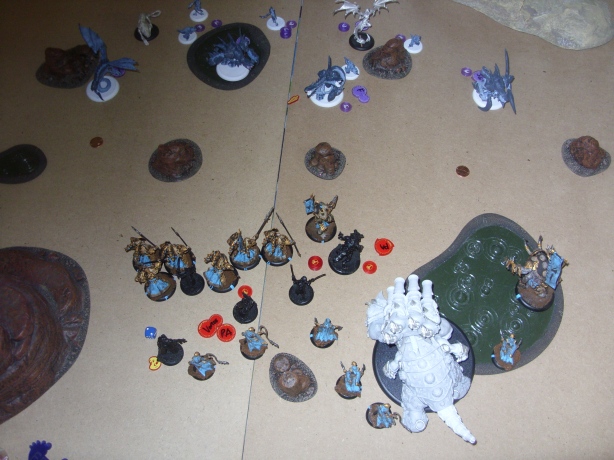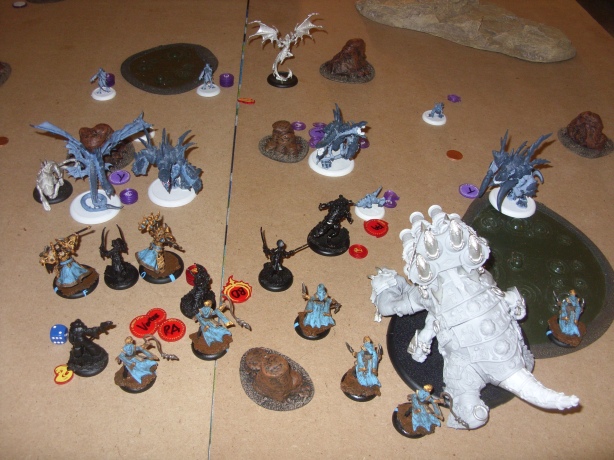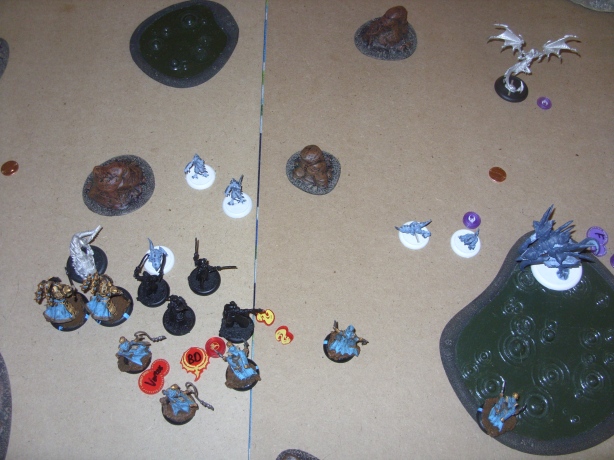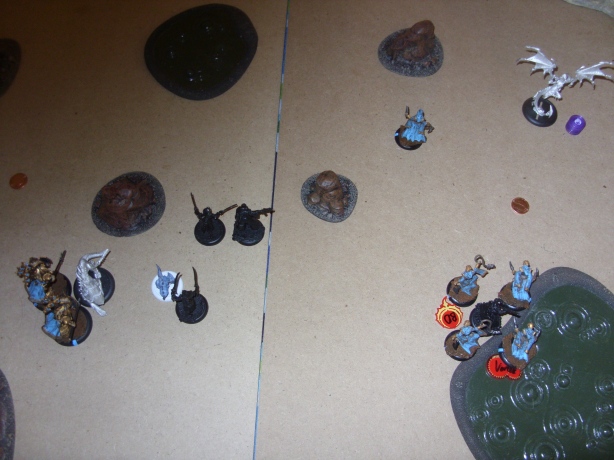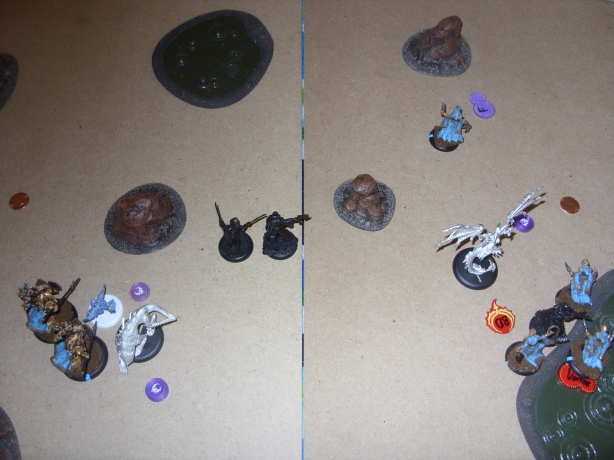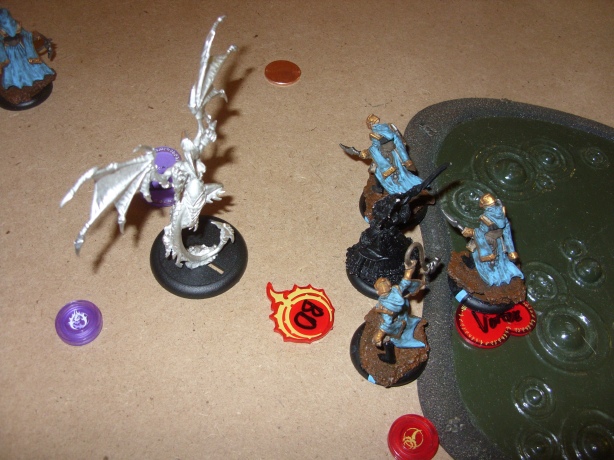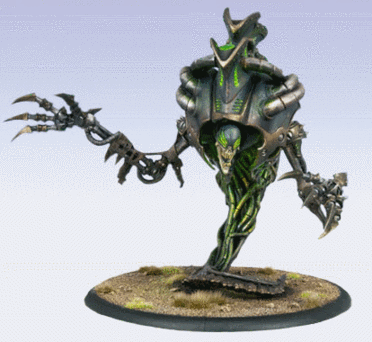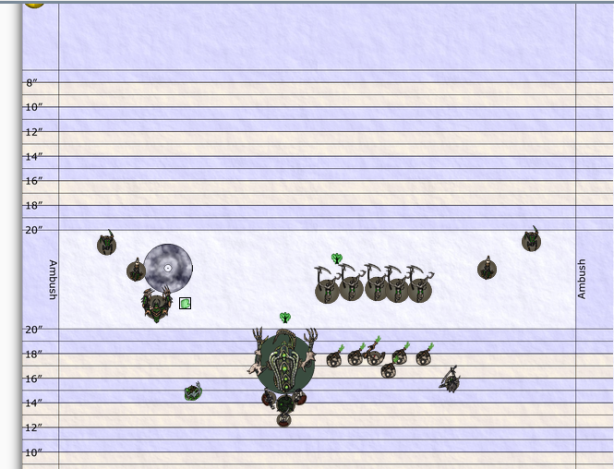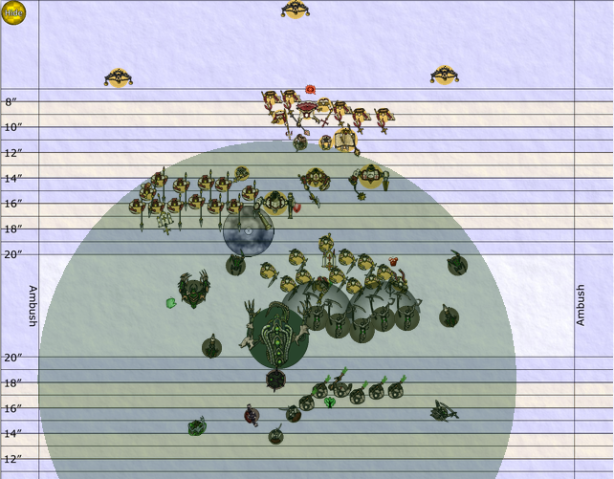One thing MidnightCarnival and I discussed pretty early on in the Mk3 Cryx release was trying to do something of a comprehensive faction review of Cryx in Mk3. All over the internet people have been extensively discussing many of the changes, but as part of our effort to chip in, we felt something that was more of a discussion and an analysis than a simple, dull, changelog would make for better reading.
So as part 1 of this article series, we turned to look at Cryx warjacks.
Slayer

Lazarus – Okay okay, Lets do something sensible with this! Basic Slayer, go!
MC – It got cheaper, it got more boxes. I mean…. it still has the same output. It gained hard head, but I mean, it got cheaper and better
Lazarus – I love it now. I hadn’t realized till today, but it has a lot of utility, simply for being the only thing in it’s pt bracket and ARM cracking being more of a premium.
MC – It still loses it’s arms. But at least you’re paying less for it.
Lazarus – Right and thing is, fragile tho he is, he fills more of a role now, simply because of the way WJP work out (and people are taking more heavies, for which hes kinda adept at taking out?
MC – The way I’m seeing the slayer is as a fire and forget missile
Lazarus – Agreed. And two nodes are only 12 pts usually. So the slayer suddenly comes in handy if ur sitting there thinking, eh, i dont want much more jack wise than this? Or alternatively, single node casters can get a Slayer, Node and usually something like a Harrower for 30. Whereas DJ would leave u short on WJP.
MC – I’m liking slayers in pairs honestly
Lazarus – Yeah, i could see that. Esp low pts levels when you need ARM cracking.
MC – Paired slayers are ok because they’re cheap, disposable and require them to put a big gun into it
Lazarus – And yeah im noticing fragile tho they are, theyr more functional now. Powerup leaves them pretty independent tbh.
MC – Power up is the reason why I’m ok with taking them as a pair.
Lazarus – Little bit sad about the “2 extra boxes” rumor being untrue mind. But yeah with Banes being such a problem child to deliver, the Slayer I think actually has a place now. Esp if u don’t have ARM debuffs and esp in a more jack friendly meta, where they can usually alpha at least. Which is such a weird place to be in.
Reaper
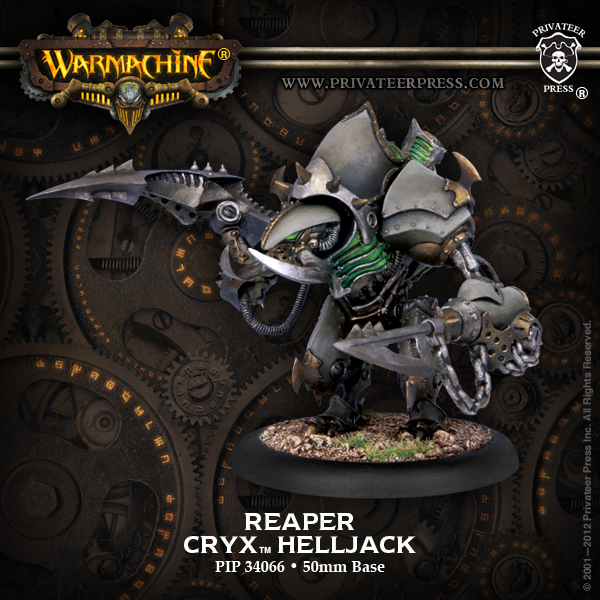
Lazarus. So the Reaper. Identical apart from standard tusk changes (1″ rng, Hard head), and just a touch cheaper. Honestly, i like it. But god i wish it was 12pts. Would that be fair to say? If it was 12, id love it to pieces
MC – I like the reaper. I still think the reaper is just as good as it has been. And I think the reaper is pretty fair where it is. You’ll never use hard head mind you, but it’s still got a place as far as beingt able to pull people around
Lazarus – You see, at 12 it’d be an easy sell for fitting a great space between springing a little extra for the Inflictor and dropping pts for the Slayer. But im not sure trading the gun for the Inflictors Shield is worth it for the same cost atm? Even if sustained is better.
MC – I think it can be because if people are going to be taking more heavies and less colossals again, then the reaper will have targets
Lazarus – True. It’s very much a meta question. And ofc the eternal Malice comparison we’ll get to haha.
Corruptor

MC – I think the thing I’m most excited for with the corrupter is the change to the necroburster. Ahe arc node warrior model having 360 is really good. So, here’s a funny thing for you. You shoot an opposing unit with the corrupter, and have venethrax channel 2 dead weights through the new arc node. That kills 2 more infantry models and can make 2 opposing heavies forfeit movement or action. So if they have the infantry close to their jacks at all, you can seriously screw them for it, in particular, say…choir boys
Lazarus – The corruptor got a lot better. Im a little surprised at the cost, but he got majorly buffed. Extra POW, bigger blast, 360 arc, bigger heal, immunity corrosion (eh). It’s a big list of changes
MC – For me, the biggest change by far is the 360 arc. That just opens up so many tactical options for getting spells where people don’t want you to have them
Lazarus – It’s bascially everything we always wanted for the jack – Reliable healing. Check (Esp now Skarre cant have the necrosurgeon do it!) – Really good arc node. Check – Huge ranged anti infantry AND viable anti-heavy gun (esp now the Levi got nerfed). Check. And better in melee to boot.
MC – Is the gun really enough though? For dealing with heavies. I really like it for shredding infantry.
Lazarus – No. But I like the utility of it.
MC – Ok, that’s fair then. It’s got great utility uses, just not a good anti-heavy gun.
Lazarus – I guess I meant vs heavies, I had the following in mind. Generally speaking, it’s a weakness of some dedicated anti-infantry pieces that they can’t do anything to heavies if the troops are dead. However,this thing can sit in the 12″ sweet spot and put a boosted 14 into something, maybe take a column with some luck (Read: Debuffs)
MC – Just hit the warbeast with mortality first, haha
Lazarus – Agreed. So the anti-heavy gun part i mean as backup. As in, if u dont need a node right now, or don’t need to pop troops. A better example maybe would be solo busting (along with the harrower) because hes got a 18″ unassisted threat with a solo killing gun for 0 focus needed (powerup). Thats nice to have. So all in all, he can do a little of everything basically.
MC – Yeah, I’m not sure he’s got a very dedicated role, but at least he’s cheap. Side note…I may be comparing every warjack to either being used with venethrax or shade3 because they’re probably 2 of our best casters for running warjacks
Laarus – Put it this way. I don’t know where to take him, yet (Venny maybe). But the key point is, now i WANT to take him. Which is a huge improvement.
MC – For sure
Leviathan

MC – So, I have 1 issue with the levaithan, and only 1 Let’s see if you can guess what that single issue is
Lazarus – Well the ROF is rele the only difference. But im gonna go out on a limb and say the problem is the same one it had end of mk2 – Seppy exists now.
MC – Yeah, see, that’s just it. The sepulchre exists and is straight up better because the sepulchre is a ROF4 effectively, while the leviathan is now ROF D3. And if there’s one thing I dislike greatly, it’s an unreliable ROF
Lazarus – I agree entirely. I can’t stand unreliability. If it had Reload at least… But i worry that I’m done w the Levi. Into the trash heap i think it goes I think. I already had problems with it in Mk2 struggling to find a role.
MC – I don’t think it’s quite THAT bad. But it’s pretty bad without being able to get a reliable ROF2 or ROF3. Hell, if it was straight ROF2 and cheaper, I would be fine
Lazarus – See thing is, im not taking it. I’d rather a corruptor now (Wow, up is down lol!)
MC – You know, I think the only time I’ve ever said I’d rather take a corruptor over something is over a seether.
Lazarus – Or more importantly, a Harrower. Boom. Now THERES a jack….for the SAME cost!
Harrower

MC – Best non-character jack in the faction. I’ve said it all throughout MK2, and I stand by that. I still think it’s the best non-character jack we have
Lazarus – See and thats why im never looking at a levi again at this rate. I just dont care when i can take a Harrower for that price. So lets get this lovefest outta the way. I think it’s unanimous, we both agree the Harrower is friggin amazing
MC – It gets so dumb with murderous. Shade3 gives them murderous, if you don’t need the hit buff, then it gets dark shroud
The fact that it collects souls within 5″ that convert during it’s activation rather than at the start of turn is pretty damn good
Lazarus – Murderous from 3shade yeah. Coven, ugh im too bitter to discuss them still 😉
MC – Ok, fair. But, like the harrower with terminal velocity, or you know, 2 harrowers with terminal velocity
Lazarus – Its just so much better at what it does, and now cheaper too.
MC – Yeah, and when they made it cheaper, I was ecstatic
Lazarus – The only thing u gotta be careful of is… 1 – Greater collection range not boning other models (rarely a problem) and 2.) Souls only convert next turn, so u need to make sure u actually live that long. But other than that, totally worth it. The other big change is to ghost shot, which is actually much better. You spend the soul and not only gain ghost shot, the shot is fully boosted too! (!!!). So u whack a bunch of guys, churn up souls, and send a fully boosted shot into some solo, clustered troops (boosted damage on the WHOLE AOE!) or whatever. Crazy crazy good
MC – Yeah, I just can’t believe they made it better honestly. It was already nuts in MK2, and then they made it better and cheaper.
Lazarus – Also, Harrower is +1 rng now. Because, reasons? And the gun is magical. Haha
MC – Pretty sure I’m starting most of my battlegroups now with 2 harrowers. Yeah, it’s really really goodI don’t understand why they needed to buff it, but given that I’ve had for a really long time now, I’m in no way shape or form complaining
Desecrator

Lazarus – Ok, Desecrator?
MC – I still dont like it. Accumulator “our most nerfed unit”
Lazarus – At least it works on all banes. But yes (I never understood why it had that anyway). Grievous Wounds is nice tho. And +1 RNG helps, tho it rele needed to be rng 12.
MC – Accumulator satyxis makes way more sense on the crabs
Lazarus – I know right? heh
MC – Grievous wounds is solid. The big thing to note is that grievous wounds stops repairs now
Lazarus – Oh, and the jack is cheaper.
MC – Yeah. I can already tell you the new grievous wounds is going to annoy the hell out of me when I’m playing gargossals
Lazarus – So yeah. I mean the Desecrator didn’t get fixed exactly, but it did get some help. It basically only ever needs 1 focus now (and even then, only for melee) and it got a bit of a bump. But i think i wont have room for it most of the time? So def on my “maybe” pile, as i used it w eLich a few times before I guess…
MC – Oh ok, I just haven’t really seen any appeal to it
Lazarus – Ironically, i think the corruptor kinda kills the desecrator, as i can just whack troops that way now, and yeah, utility. But im months from knowing that for sure, as both are highly “meta” dependent pieces
MC – I just don’t see the point in the desecrator
Lazarus – It doesnt do anything i need doing atm. But if GW and scather gets needed, ill look into it
MC – I also think that things may not be as pillowfisted as they first appear at least as far as an assassination value goes. And see, crab chassis is still the superior chassis because of pathfinder, and steady also, the slightly better damage grid
Lazarus – Pretty much. And now ghost walk is a lot less prevalent…
Inflictor

Lazarus – Anyway, let’s do the Inflictor 😀
MC – Still the same amazing warjack. Shield guard is even better now than it was before
Lazarus – Tho u cant catch sprays. So there is something to keep in mind there. And without soul drive, he is no more focus efficient than other choices. That being said, durable, cheap, reach still means sold basically
MC – To be fair……….every jack got soul drive. Power up basically killed the need for soul drive to exist as a rule
Lazarus – Well agreed. Im just saying hes no longer filling that niche as focus efficient jack compared to anything else… Lol thats for the desecrator now 😉 kidding…
MC – Haha! I think the slayer is definitely the new focus efficient slot. But the fact that he kept shield guard is huge. And yeah i always like the inflictor. Hes less bonkers on morty now, but venny loves him mre than ever basically
Lazarus – And now, the Seether. Sigh
Seether

MC – The seether is still unplayable trash. I mean, on the PLUS side…. it’s only 3 points more than a slayer. On the downside….skornergy and it got worse
Lazarus – yeah on the Seether im inclined to agree. I dont want it
MC – My opinion on the seether hasn’t changed. Uncontrollable rage is straight up bad. I mean, it’s not HORRIBLE because the slayer chassis has no guns anyways…
Lazarus – Yeah i just wish it was free charges, not MUST charge.
MC – But it feels like a fluffy rule that’s just terrible
Lazarus – So the bigger problem is Barathrum, who is a straight upgrade. Unless pts are very tight, im taking him every time
MC – Well, I’nm taking a harrower everytime really. If I want an infantry killer, the harrower is straight better because of reach and thresher… Also, needing to charge makes hard head completely pointless
Lazarus – That too. Berserk without reach or overttake as well….:(
MC – And countercharge? Venethrax exists, and barathrum has it anyway. I legit can’t say anything good about the seether. I’m trying, but there’s literally nothing good to say. They basically found a way to make a bad model WORSE.
Lazarus – Ok, so if we are trying to be fair to the seether mind… Hes a LOT cheaper (now only 1.5 pts equiv over the slayer vs 3 pts more), he does more damage now (+1 pow), he’s less vulnerable to crippled systems (no chain attack) and uncontrollable rage, ironically, can be controlled. He just runs 0.01″ basically. Really the loss of DEF is what is silly. It should have gone UP, not DOWN
MC – It needs to go back to 14/17 like it was in MK1. That was part of what made the seether actually good in mk1
Lazarus – Im not optimistic on the seether. But as ill now have parts for one, via the multi kit, ill certainly test it.
Nodes

Lazarus – Ok lights. Nodes all together? (Seeing as theyr mostly similar)
MC – Yeah, that makes sense. Especially given that most of the nodes lost their combat capabilities. I mean, realistically, when it comes to the nodes, they’re effectively better for their primary purpose. The defiler and the ripjaw losing combat capabilities sucks, but them being cheaper is a fine trade off
Lazarus – Yeah basically nodes just got more streamlined in their role. The loss of DEF is what hurts the most i think actually, but that’s a problem for all Cryx lights
MC – It is, but at the same time, I think the decrease was pretty much across the board. Like, if you notice, most of the high def got neutered
Lazarus – Yeah pretty much. The one model u rele have to watch now w nodes is bloody Kell. Who can just look at one funny and straight up remove the node. Hitting on 4s, auto 3 damage x2. Bye bye node. Irritating.
MC – Yeah, it’s actually a big problem. But see, part of that makes me wonder if a third node may be potentially worthwhile? Though to be fair, I think at that point, I can just take a corruptor and have a flexible third node
Lazarus – Nodes being cheaper doesnt mean as much as it wld in mk2 mind. It basically just means a slightly better jack choice for the rest of your WJP now in practice. And iv thought about 3+ nodes, but the lack of external utility beyond arcing makes me have doubts now more than I even did in Mk2 about nodes, as they cover fewer bases now.
MC – Yeah, thats my thought too. Corruptor all the way now lol. Basically, the defiler and ripjaw lost the most in that respect.
Lazarus – Defiler the most, being a full 2pts more
MC – Yeah, defiler still has uses though. Sprays are better now than ever, but the problem is that it’s spray got weaker
Lazarus – Ripjaw traded the super weird vice lock for powerful attack, which is annoying. Losing Vice Lock is a shame, but he might get used for one simple reason – hes only 1pt more than a Deathripper, and sometimes, u will have a point somewhere (esp if its a WJP). The fact that he’s only Crit ARM piercing though is what kills it utterly for me.
MC – I liked vice lock though, it had a lot of really weird cornercase applications that were really really good. So to me, the ripjaw lacks appeal because if I want a combat jack, I’ll take a stalker now or cankerworm. And for 1 point, you can take a soultrapper
Lazarus – Hey, there’s always spare WJP! And thats the thing w cryx jacks i find odd, that some of them could have been so much more appealing in the new high WJP meta if they were costed in the right bracket. But yeah, i dont like luck, so I’m not interested largely 😉
MC – Altho now at least it can potentially armor pierce on all attacks
Lazarus – Hehe yeah, i guess….
MC – To me though, the nodes are strictly nodes now
Lazarus – Basically. And Defiler losing 2 pow is yeesh btw
MC – It’s a big hit It still has a place because there are still things that you want to spray down
Lazarus – The one that saddens me most though is the nightwretch. It being auto 3″ AOE is good, but it utterly KILLED the Deathripper vs Nightwretch debate by being 1pt more now. Game over, Deathripper wins.
MC – Right, like the others, it’s more of an opportunity upgrade. For a node, yeah, I think the deathripper is probably straight up a better choice being the cheapest node, and 9 times out of 10, the nodes did nothing but arc.
Lazarus – See now its between paying 1pt to upgrade a DR to a NW or a Ripjaw.
MC – Which means that in those exact same situations, a deathripper is the better choice
Lazarus – And most of the time, i wont pay that pt unless i have it spare
Scavenger

MC – I’m not sure if the scavenger really has a place. My biggest issue with the scavenger at the moment is that when I put it next to the stalker, there’s nothing appealing to the scavenger
Lazarus – In theory, I should like the Scavenger. It kept most of what it needed to, and got a touch cheaper too. Generally like before u still want the Stalker, but now they arent priced the same. That being said, the only casters that rele bothered with the Scavenger before (Morty and Coven) both changed and took a hit respectively, which definitely alters their use case. So im putting it under “decent, but i just dont know where to actually put it?”
MC – The bigger issue is the fragility. Unlike the Stalker or Helldiver it doesnt have a defense mechanism, and it’s not as cheap as a node (while being closer to the action as a melee piece). That means i think they just die. And it lost a point of defence didn’t it?
Lazarus – Yeah. I think pretty much every cryx light did.
MC – See, and to me,that seals the deal. The stalker still has stealth. And while i get that flight is a really good rule, we have a unit of these guys now. And the scavenger is even more fragile than it was before
Lazarus – Yeah actually thinking about it more i think ur right, the loss of DEF and not having Ghostly + TV on the same caster anymore wrecks the terror bird. Maybe, maybe Coven will still work, but its gonna be tight
MC – If goreshade1 still had shadowmancer being the same, then I could maybe see a spot there. But with the change there, I wouldn’t even consider it there now
Stalker

Lazarus – Ok, stalkers?
MC – Sure. Stalkers are STILL absolutely amazing. The biggest benefit for them came from the change to backstrikes and then them gaining leap.
Lazarus – I agree. Stalkers are amazing. However, I will say they have had a definite role switch. They’re very very good for sniping out support models now They are now arguably MUCH better at solo hunting or picking off UAs than going after casters. The loss of AA and the changes to grevious wounds, combined with the way that camping works and having to spend a focus to leap (fewer attacks), means that assassination is generally off the table. That being said, they are AMAZING at cleaning up the backfield. So i see them closer to a Cryx Raek than their old role?
MC – For sure, and raeks are amazing as well. Stalkers and raeks are crazy good
Lazarus – Exactly. So stalkers are really good and will see plenty of gametime. You just have to use them differently.
MC – Venethrax with 4 stalkers
Lazarus – Yes. Still good with Morty (the ovverrun changes, AD + leap means they can get to the opponents DZ in almost a single turn lol). And Coven aint bad with them still ofc either.
MC – I still love them with shade3. But the big issue I have with them now wide shade3 is that I no longer play him for assassination first. Which means that the purely assassinatino module is gone. That being said, stalkers on aiakos are still delicious
Lazarus – Oh yes. And 3Shade. But i think ur right, his focus away from being assassination is likely to see them dropped for attrition pieces.
MC – For sure, also, stalkers should not be 8 points. And this is where the comparison with the scavenger happens. See the scavenger flies, but the stalker will just leap instead
Lazarus – That’s true. Also worth a note – them gaining AD means the combo with leap is just ridiculous threat improvement. They’re already 6″ further up turn one and now threat +5″ further
MC – Yeah, AD is another thing is just another thing that they gained that they didn’t need
Lazarus – i think its more a problem that the Scavenger needs to be 6 than the stalker needs to be 9. And Scavenger should have kept the higher DEF. Ya know, for being more movable
MC – I own 4 stalkers already, and I’m so glad I do.
Lazarus – Oh, AND stalker gained 1″ reach, while the Scavenger kept 0.5 :(. So we’re actually talking a 5.5″ increase in threat AND a 6″ increase in board position. Nuts. Ok, so onto the Shrike
Shrike

MC – So…the scavenger is bad…and shrike is a slightly better scavenger
Lazarus – Well the shrike did get massive improvements, which we should discuss at least. Its only nerf was losing 1 DEF, as did most cryx jacks. But its:
– Cheaper
– Free tramples now
– Boosted attack rolls
So its at least not a “terrible” choice, as now it can reliably wipe any infantry it hops over.
MC – But it didn’t gain any defensive tech, and that’s where my big issue with it.
Lazarus – Now i dunno if that’ll be enough by itself, but im at least not writing it off like its mk2 version. And i agree, thats still a concern. Now its more of a “probably not” choice than a “garbage pile” choice.
MC – I dunno, I still think it’s really bad because cryx lights need something to not be die to hand cannons. And stalkers have that, but shrike and scavengers don’t.
Lazarus – Right. So i think it’ll depend for me how the meta pans out. If we see a lot of boosted attack shooting for example, shrikes are worthless.
MC – And with bigger battlegroups, I think it’ll be the case
Lazarus – Esp now that a lot of cheap jammers are out. But ill reserve judgement for now because it def got better at what it does and cheaper, so im more inclined to at least consider it, even if as you said, its still probably a “nah, stalker” choice overall. Ill also note that the nerfs to biles also greatly impact it’s consideration as well.
MC – Yeah, and that’s just it….compared to the stalker, both the other 2 options are just not good
Lazarus – They are cheaper tho. It might be all they have going for them – a situation where u can’t fit a stalker, but u wouldnt mind a solo hunter or some such. It’s at least enough to leave them on the “reserve” bench i think, but im inclined to agree.
Helldiver

MC – Holy crap…did burrow get nerfed
Lazarus – Indeed. Im not gonna lie, im kinda glad that even tho i have 2 Scavengers (lol) that i dont have any helldivers
MC – I’m pretty sure burrow got completely gutted. It lost a lot of vectors, and basically….I’m at a point with the helldiver where I’m not sure I would ever take it over a stalker. Not being able to attack the turn it unburrows is a huge hit, not being able to reburrow is an even bigger one
Lazarus – I would never buy one. So that probs says it all
MC – I own 2….I think they may be relegated to being slam targets. Except with the new change to the throw rules, that’s not even necessary
Lazarus – Yeah i just think they got hit too hard with the nerf bat. Burrow in general did, and while the dig in + drag below trick is cute, id rather Barathrum for that than 2 helldivers say.
MC – Probably the second most heavily nerfed model we have
Lazarus – But, i will confess that not actually owning any, my advice concerning helldivers isnt worth all that much. Altho i doubt experience counts for much either given how much they changed
MC – They lost too much
Lazarus – The thing is, overall, im just not sure what their targets are supposed to be now?
MC – They basically got gutted and while I agree that they needed to do something about them, they got hit to the point where they’re pretty much pointless. Even if they took away the ability to re-burrow and retained the ability to attack the turn they unburrow, that would have been fine. But the fact that they took BOTH of that away, means that there’s nothing for helldivers to do now
Lazarus – I agree. Or even if the burrow marker could move faster than a hilariously lousy 3″ a turn! Then it wouldnt matter if it had to forfeit
MC – You saunter up really slowly, then get shot the turn you unborrow. Great, you spent points doing nothing
Lazarus – Yup. Its silly
MC – Basically, the only combat light so far that I would even consider is the stalker
Lazarus – Heres the problem with the Helldiver – compare to the mk2 Razorworm. Also had AD, similar-ish stats, had dig in and drag below. Even had the advantage of the fury system and an animus (admittedly 4 pts). And nobody took it, nobody. It was hot garbage. So its basically a shitty razorworm with a terrible burrow rule attached. Nobody is gonna care.
MC – Pretty much. Stalkers and cankerworm all day, every day
Lazarus – There is one other light im taking, and thats our next choice
MC – We have 2 really really good combat lights, and 3 godawful ones
Cankerworm

Lazarus – Cankers! The loveable guy is just straight up better and i adore cankers
MC – He’s actually better, which I didn’t think was possible, but he got better
Lazarus – Yup. I was shocked. Him being 9 pts is an AMAZING price point. Gotta shave 1 pt off a Slayer? Boom. Got a spare point? Upgrade a stalker. Boom.
MC – Kept everything about him that made him great, still has one of the best damage grids in the game
MC – I think in every case, I would take cankerworm before a slayer. Stealth is a much bigger deal now and cankerworm still has it. Granted, his bond is worse now.
Lazarus – Yup. Id argue the mild loss of reposition (straight 5 vs full advance) is rele no biggie. I much prefer Salvage/Adapt now for being less clunky and now will come up more often.
MC – The salvage and adapt changes are way simpler now
Lazarus – Oh, and not costing a focus!
MC – Yeah, and salvage is just better now. Which again, could not understand why they did that, but I won’t complain. He’s still a 9 point autoinclude for me in lich3
Lazarus – I think its that all imprints are gone. Which is big for Nightmare, who we’ll get to soon heh. And yeah agreed. Also, interesting i think he opens up in a big way for morty, as he no longer breaks tier ofc.
MC – He’s also going to shine with more jacks on the table
Lazarus – But yeah largely being the same with minor buffs basically means hes as good as everr with the new advantage of agressive price points for list construction and more jack heavy meta
MC – “Please give me your gun victor” Oh, and free focus is great
Malice

Lazarus – So only something a bit different on the char spectrum. Malice
MC – Ok, I’m at a loss with malice again because malice got better, and at the same time, I have the same malice vs reaper issue
Lazarus – Malice does confuse me a bit. The inability to immediately use souls for attacks is minor, but the loss of starting soul via well of souls is more problematic.
MC – Possession is better, don’t get me wrong
Lazarus – Why, as u can control chars now?
MC – Teah, especially with more people taking character jacks across multiople lists. Taking over ruin and then having him cleave butcher in half will be glorious, especially when you combine that with a few machine wraiths
Lazarus – Shes also now in an uncomfortable points bracket with many other great choices
MC – Possession is actually fantastic. But the reaper has a 2″ sustained attack weapon and hits harder
Lazarus – Agreed. The bigger problem i think is ur gonna have to set it up more, because the lack of starting soul means u do have to order of operations correctly (or trapper, which has its own issues) to get her going
MC – I still think I’d rather have a reaper in all honesty
Lazarus – But yeah otherwise her role is similar – good at dragging heavies as a setup for your army. If the meta is less gargossal friendly then she has more opportunities to shine.
MC – I’d rather drag something in and kill it Rather than drag something in, move something else closer to expose it and then probably lose 2 of my feather armoured heavies
Lazarus – Probably? The other interesting point is that now shes only 1 pt off a Reaper, not 2. And yes, tho Malice is more likely TO drag somebody (+1RAT and +2 POW)
MC – Malice is definitely better at it, but the reaper will output more damage overall. The reaper will drag in and do a TON of damage. Malice will drag in…and probably miss at least 1 attack? Reaper will do half of a heavies boxes to it probably
Lazarus – So it depends right. Malice does 2 more damage on the drag, vs. the Reapers +1 POW. But, if the reaper is more likely to boost the harpoon (either hit, damage, or both) vs. Malice, then i don’t know
MC – Yeah, reaper will more likely boost at least one of the rolls, but won’t need to boost the attacks after. Malice definitely feels like an actual utility heavy, but I’m not paying 14 points for that
Lazarus – Both boost vs ARM 19 heavy- Reaper should do 3 damage with the harpoon, Malice 5. Then free attack, Reaper does 4 Malice 3. Then bought attacks x2 (8 vs. 6) . So we’re talking a difference of 1 damage.
MC – But it’s that you need to roll to hit with malice, whereas the reaper doesn’t. So if your target is a higher DEF warbeast, the reaper is significantly better
Lazarus – And yes, the Reaper is auto hitting vs. Mat 7. However, Malice is more likely to hit with the drag. So calculating THAT is tricky.
MC – 15 points for malice even, not 14
MC – I will say, the open fist does have some good uses over just the piston. And yeah, soul harvester being a 5″ collect is actually quite good
Lazarus – Agreed gathering in 5 is still a nice buff for her.
MC – So it’s not that malice is bad, it’s just that I’m willing to give up sustained attack and 2″ melee range
Lazarus – Yeah. Im def leaving her in my maybe pile. She is very good, and potentially amazing if the meta favors her in the future.
Erebus

Lazarus – Now my favorite choice – Erebus. Who i would argue is an absolute god in Cryx now.
MC – Erebus got real good, specifically with scaverous. He’s good with other casters too, but you really see him shine with scaverous. And 1″ melee range is a big deal when you have overtake..
Lazarus – Stationary is incredible, immunity cold is sometimes clutch, and 1″ reach benefits him more than any other standard jack because of overtake, as you said.
MC – Stationary is fantastic
Lazarus – Oh and Morty. I love him w Morty. And im also gonna make a case for Venny
MC – See, this is the thing, erebus has the defensive stats that the reknown chassis should have had
Lazarus – Straight up stationary is rele rele big for us, as we lost a lot of setup type abilities, and most of our heavies can’t 1 round (but can cripple) handily, which stationary is great for. Even if ur target lives to shake, his great defensive stats and them being 1 less focus/fury means he might actually survive retaliation. All it takes now is a crippled cortex to make him completely safe, or crippled arms which with one less focus (shake) means he ain’t going anywhere. And yes, on the renown chassis, agreed!
MC – When you combine that with scaverous’ Knowledge of the Damned ability, poltergeist and Starcrossed from wrongeye and snapjaw, your opponent is going to have a really hard time digging out erebus.
Lazarus – So Erebus, who i already had a soft spot for, got amazing id argue. He’s unique for being an AMAZING soultion to medium wound infantry, and i think we’ll still see things like MOWs a lot now Ah, and I almost forgot – Terminus ravager trick as well is just better
MC – Especially since you can stick deathward on erebus too. 14/20, poltergeist, force your opponent to reroll successful hits, pick the column you take damage on….AND he can collect souls for scaverous to power knowledge of the damned. And yeah, he’s really strong for medium based infantry
Lazarus – Yup. Autoinclude w Scavs. I already liked him there, but even more so now
MC – The 1″ melee range chain with overtake to get the train started is real good for scaverous. And I would make a case for all of the heavies basically wanting to be with their assigned casters because of how good the bonds are
Lazarus – Also last point w Scavs – TK + Erebus. Love… Totally diffuse opposing heavies from being able to touch him, line up perfect chains. Hilarious
MC – Even better though is that erebus kills a guy, gives a soul to scaverous, you can use that soul immediately to reroll any misses. that is a VERY strong duo now. And of course, also abuse that with starcrossed to deal with any retaliation they may have
Barathrum

Lazarus – Ok. Now an interesting choice. Barathrum. Who is now priced correctly I feel
MC – I don’t know how I feel about barathrum. He’s actually very very good for his points. 15 points is where he should be, and dig in and the same solid defensive stats means he gets there
Lazarus – I like Barathrum a lot more (but I was always a fanboy of everything but his price).
MC – Same ol’ AD
Lazarus – And countercharge
MC – Countercharge is good, drag below is cute.
Lazarus – He lost souldrive but it doesnt matter because powerup
MC – Again, I think this is a case of better with his assigned caster, because unyielding is a big deal
Lazarus – Yeah he got a lot more sensible w Terminus, which made no sense in mk2.
MC – You could put him with skarre2 or scaverous as well, who can help him with an armour buff, or deneghra1 who can crippling grasp whatever tries to get into him.
Lazarus – Drag below did get a slight nerf – it can’t work on beasts anymore, just warriors. BUT the fact that u now don’t take free strikes anymore probably means that Drag below is still better most of the time than it used to be.
MC – So I mean, stilt legs will see play. And that’s true, drag below is probably better than I’m seeing at first glance
Lazarus – Yeah the free strike immunity is very important for him. In the minimal games i played in mk2 with him, i felt he was much stronger once he had Ghostly. This is even more important in mk3, where ghostly is actually harder to come by with fewer Ghost Walk options.
MC – I still really like him with terminus more than other casters, especially since ravager on him is going to be strong still.
Lazarus – Oh, and standard hard head. So basically, Barathrum got better overall, and cheaper. Morty, Coven and Venny are my other places im playing him, and im still thinking maybe gaspy3.
and at that point, you’ve already been engaged and can trigger berserk now
it doesn’t stay, that’s right
but you’ve gotten a free advance mid combat action and then continued your attack string
Nightmare

Lazarus – Anyway onto our next biggie. Nightmare. Whos an interesting devil, but id argue is overall better
MC – Ok, denny’s my girl, and I gotta say…I still love nightmare with her. Again, I go back to stealth being a big deal right now, so as he gains stealth with her, on a heavy with prey, and a chain attack, that’s a big deal. Especially as he has 2 open fists for being able to do all power attacks and hard head to benefit from the power attacks that don’t use his fists
Lazarus – Lost reach though, which blows. And he traded combo strike for chain attack G&S. But, getting effectively cheaper, stealth being better and just being STRAIGHT ghostly is massive. Oh, and +1 POW. Because heh why not? So Nightmare better im gonna say?
MC – Nightmare definitely got better. I’m ok with losing the combo strike for chain attack. It gives him more of an identity
Lazarus – I agree. Chain Attack is always good (at the very least it’s free damage from a headbutt, often knockdown) whereas Combo was only even an option that you used some of the time. I want to say that unless you’re tackling high-end ARM, you’ll still output more damage with all the initials + headbutt than you would with the combo anyway, especially now you’ve got the extra POW over old Nightmare.
MC – Oh and especially with the seether losing chain attack, nightmare just basically said “i’m better than you in every way, suck it”. So I mean, I liked nightmare before, and I like him even more now
Lazarus – Haha yes, true. Massively more expensive tho ofc than the Seether. Seether is still outdated because Barathrum tho, who outdamages it
MC – Especially since chain attack: Grab and smash ACTUALLY has synergy with hard head, unlike on the seether where uncontrollable rage and hard head are skornergy
Lazarus – Haha actually YES
MC – Pretty sure I’m always taking nightmare with a deneghra
Lazarus – Esp D2
MC – Both 2 and 3. Really, power up made it so that he works well with all the deneghras
Lazarus – Agreed. It was always his main issue w D1 and D2, so that helps a fair bit
Deathjack

Lazarus – Ok, now – DJ?
MC – Ok, so deathjack got hit the same way that all spell slaves got hit. Even though necromancy is better than spell slave because you don’t have to worry about the focus limitation on the spell, the fact that deathjack can’t upkeep cycle is a big deal. He lost 360 arc, which is…..maybe a buff? Snacking is worse than his healing mechanic before and hard head is whatever
Lazarus – He did. And yeah the snacking also turns off his ability to gather souls which is the bigger problem, namely, losing cull soul
MC – But he did keep the good defensive stats, still hits just as hard, and still keeps skulls of hate. Losing cull soul is weird… I still love deathjack personally, and I think deathjack will still have a place with some casters. For example…deneghra2 will still adore him
Lazarus – And more importantly, tho we lament these small nerfs, we need his arm cracking. Nightmare did close the gap, but hes still our hardest hitting heavy and we’re likely to need that in mk3
MC – Venethrax will adore him because he can cast mortality. He still allows for double hellmouth on D2. So there are some setups he’s designed for.
Lazarus – Yeah the spell slave changes mostly hurt people like Coven, 3Lich etc.
MC – He lost his place in lists where you need him to help cycle upkeeps early on. I think now, you’ll see deathjack reserved for lists that actually have spells for him to cast, basically, non-upkeeps, so things like mortality, influence, hellmouth, and here’s a big one….he gives venethrax an extra deadweight. I think he’s still brutally strong but I think he no longer belongs in skarre2. He’s still really strong in terminus, but skarre2 lost perdition, and she has mostly upkeeps now. And deathjack can cast ravager for terminus
Lazarus – So im going caster by caster here in terms of Spell Slave (not considering him as a beatstick in this)
Agathia – Nope
D1 – Nope
D2 – Yes
D3 – Probably
Shade1 – Less likely?
Shade2 – Nah
Shade3 – Nah
pGaspy – Nah
eGaspy – Nah
3Gaspy – Nah, no need now
Terminus – More likely now, but i think Barathrum first, Erebus 2nd, so probs no
pSkarre – Maybe
eSkarre – Much more dubious i agree. Not so much for the upkeep spells, which sucks, but the feat and loss of Perdition
Scavvy – No room? Still very strong but i dont think i have space
Sturgis – Don’t care
Venny – Great
Morty – Also great
Coven – Nah, better choices
MC – I wouldn’t take him in scaverous. Venethrax and e/3 deneghra are his best casters right now
Lazarus – So that’s my main list. Now obv some of those casters might still reach for DJ for pure muscle beatstick reasons, but thats also more of an investment than Barathrum or Nightmare, at a full 8 and 5 pts more respectively
MC – See, once again, I think the reason for deathjack will fall to “is there something useful for him to cast”. He can still cast overrrun which is nice
Lazarus – But yeah he lost a lot of utility and i think the bumps in other character powerhouses (who are often cheaper) and nerfs to spell slaves will see him as a much more situational piece than how he was used in mk2.
MC – But we have a surprising number of upkeeps. And I think that’s what it comes down to, is how good the spell slave will be
Lazarus – Yeah so Morty, D2 and Venny are my main ones now for him. The rest im just leavign to meta decisions
MC – Venethrax, deneghra2, deneghra3 are places where I can definitely see him being good. And terminus. I’m not sure I like him in lich3 anymore, I mean, don’t get me wrong, deathjack with unyielding is scary, but deathjack literally cannot cast anything on asphyxious3’s spell list that isn’t hellfire/hex blast, and I’m not paying 23 points for that. Lich can just cast it himself, since you aren’t gaining anything more.
Lazarus – See Terminus im gonna vote no – I still want Erebus for the Ravager trick (even better now, as is Erebus) and Barathrum.
MC – It’s got to pull weight like deneghra2 getting double hellmouth or venethrax getting a 3rd deadweight
Lazarus – Agreed. So yeah i stand by my list of 3 🙂
Wraith Engine

Lazarus – Anyway i should discuss the Wraith Engine. I played this piece a fair amount in mk2, so I’m quite familiar with how it worked and the various strengths and weaknesses. Chief among them of course was durability, because at only ARM 18 and the same number of boxes as a node, it was really made of glass.
Now the thing is, in Mk3, I dont think people appreciate btw that the wraith engine may well have been nerfed. It gained inscrutable (admittedly nice) speed and straight incorp. However, it lost apparition (better than 1spd) the ability to create clouds (huge!) and cleave is worse than just gathering souls quite a bit. The cloud production was just really significant for it, both in keeping itself alive and protecting other elements of the army. . So ill test but im not optimistic atm
MC – Yeah, I was thinking about that a lot lately, and I think it may have actually gotten worse
Lazarus – So ultimately, a lot is resting on the machine wraith creation ability. The utility of that is very hard to gauge as it is so completely different from everything we had before. And I rele hope it works basically, but I feel like the Wraith Engine will live and die on the ability to create new Machine Wraiths being useful. Im gonna try it, but the loss of clouds worries me and its gonna need to stand on the abilitiy to put wraiths in play
MC – I think I’ll largely defer to you on all things Wraith Engine related haha.
Colossals

Lazarus – So next up then – Kraken
MC – So the kraken kept the one thing I hated most about it, and more or less stayed the same
Lazarus – I never rele played either Cryx colossal, so my feedback is gonna be pretty limited tbh
MC – Ok, so, here’s the thing. The kraken’s flayer cannon is STILL D3+1 shots. 2-4 is….fine? But the sepulcher gets 2-6. That being said, the hellblaster is still a very very strong gun, with a potential POW17 AOE5 at RNG16 is a solid option, especially with kill shot. With appropriate support, you can kill a lot with it very quickly, but it’s still not killing another colossal. The good thing is that it still has better threat range than most colossals, especially under venethrax with terminal velocity and the 4″ reach is very very good.
Lazarus – My big question mark is mostly going to be how the meta handles colossals in general
MC – Oh and amphibious may actually be a thing now. And see, this is the thing, it hits straight harder than the sepulcher because of meat fueled, but its ranged weapons are not as good. Whereas the sepulcher has utility purposes, as well as still being a reasonably strong combat unit, the unicorn horn is interesting though because it is our longest ranged weapon.
Lazarus – Yeah as the levi basically got taken out imo, ranged power is gonna be more of a premium
MC – But then, we come to the other colossal which actually is better for cracking armour but doesn’t handle infantry as well. The kraken also has to be the model that kills to be able to throw things into the furnace which is another knock against it, but that’s neither here nor there in all honesty. It is a prime target for infernal machine still, but the kraken is stronger in melee for armour cracking for sure, going up to a whopping 22 with just a few kills. Factor in something that can swing armour and you’re in for some serious armour cracking
Lazarus – And yeah see thats the other thing. The changes to DJ n Banes makes them less desireable, which might make the colossals more necessary if ARM cracking is more important, plus they’ll play better in a meta that has issues breaking ARM with fewer tools out there in other factions

MC – So, speaking of armour cracking, the sepulcher actually lost melee armour cracking. The spawned mechs and brutes have to forfeit action when they’re put into play, but it actually GAINED in the ranged cracking department because of the changes to how ROF works, especially since it can get 2-6 impaler shots and the big gun on the sepulcher kept the crit paralysis. It lost 1″ on it’s corpse collection range, but the chain weapon on the sepulcher also has pull, which the kraken doesn’t have. So with more of a push towards spamming armour, I may be leaning with the favourability towards the sepulcher still, even though the kraken did get a bigger pie plate to deal with infantry. That being said, the 2 colossals are now significantly closer in power level now than they were before
Lazarus – I agree with that. Before Seppy was so far ahead it was hilarious, but the closing of the gap was needed
MC – Yeah, and the sepulcher also contributes to a stronger attrition game, which the kraken doesn’t. Oh, and the sepulcher has arcing fire
Lazarus – So verdict – think both will see strong play
MC – For sure. Again, venethrax, maybe denny3
Lazarus – But im still kinda glad i wont be forcing them in, because it lets me try so many other things in lists
MC – For sure, I do think that as we progress through though, we’re going to find that the gargossals are going to become more and more key in Mk3
Lazarus – I think their usage is gonna depend on the broader meta questions, but yes in principle i agree
MC – Agreed
Conclusion
So that was the end of our conversation about Cryx jacks. Mk3 has brought a lot of very exciting changes to the game, and it’s good to get some initial analysis of the models we have available to us. At the very least, it should make an interesting comparison in the years to come when opinions change about certain models and their usage gets revised
If people enjoy this more casual review format, next time, we’ll do a piece on units and continue the conversation. 🙂 Until next time!
